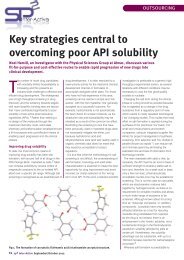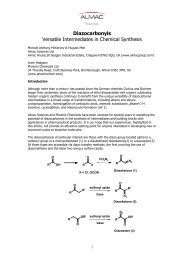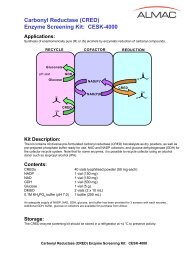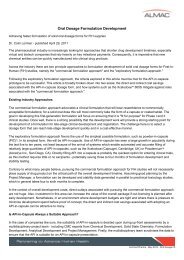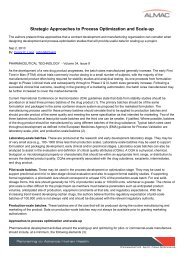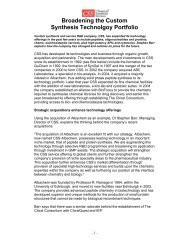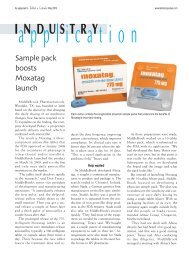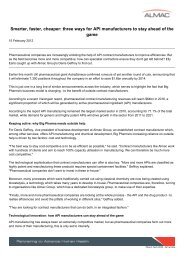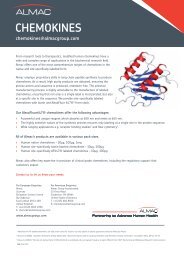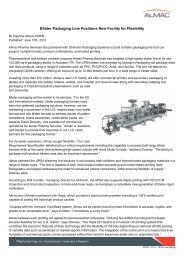Fluorescent PET (Photoinduced Electron Transfer) sensors ... - Almac
Fluorescent PET (Photoinduced Electron Transfer) sensors ... - Almac
Fluorescent PET (Photoinduced Electron Transfer) sensors ... - Almac
Create successful ePaper yourself
Turn your PDF publications into a flip-book with our unique Google optimized e-Paper software.
Interestingly, Na + in sufficient concentration displaces Zn 2+ and<br />
decreases the FE value of 27, as the smaller ion coordinates to the<br />
oxygen atoms rather than the nitrogen.<br />
Cases based on tetraazamacrocycle receptors are also useful<br />
for Zn 2+ sensing. 87 A new example is 28, 88 where the triazole<br />
group also plays a receptor role to cause selective binding of Zn 2+<br />
even over Cd 2+ , with a Zn 2+ -induced FE value of 6. Interestingly,<br />
it detects the intracellular flux of Zn 2+ during cell apoptosis.<br />
In spite of the successes concerning selective Zn 2+ sensing, Cd 2+<br />
was an interferent in many of these cases. The rarity of intracellular<br />
Cd 2+ has been the saviour in this regard. Selective Cd 2+<br />
sensing, which would be useful in studies of Cd 2+ toxicity, has<br />
been a harder nut to crack. 89–91 <strong>PET</strong> sensor 29 with a polyamide<br />
receptor provides a neat solution even within HeLa cells. 92 A<br />
Cd 2+ -induced FE value of 100 is attained. Steric hindrance<br />
between the receptor arms can produce a virtual spacer so that<br />
the usual <strong>PET</strong> behaviour can occur.<br />
Organic chemical reactions rather than ion-coordination can<br />
also lead to <strong>PET</strong>-based fluorescence switching ‘on’, as seen in<br />
30. 93 When solubilized in aqueous Tween 20 micellar solution, its<br />
amine group serves as the <strong>PET</strong> donor so that the fluorophore’s<br />
emission is ‘off’. The dangerous alkylating agent chloromethyl<br />
methyl ether forms a quaternary ammonium product which<br />
prevents <strong>PET</strong> and fluorescence is switched ‘on’. Related cases 94<br />
are known.<br />
As we saw with the 2$3 system, 18 covalent linking of a fluorophore<br />
and a <strong>PET</strong>-active receptor is not necessary for a working<br />
<strong>PET</strong> sensing system. There is no <strong>PET</strong> within 31,<br />
a tris(2,2 0 -bipyridyl)Ru(II) lumophore which is connected to<br />
a mannose-capped dendrimer. 95 Lectins, those exquisite sugarbinding<br />
proteins, rely on polyvalency. Therefore, lectins such as<br />
Concanavalin A associate strongly with 31. However, this does<br />
not produce a luminescence switch unless an extra component is<br />
provided. The extra component 32 contains arylboronic acid<br />
groups for sugar binding and a 4,4 0 -bipyridinium unit as a <strong>PET</strong><br />
acceptor. In the absence of lectin, 31 and 32 associate so that <strong>PET</strong><br />
takes place and the luminescence is ‘off’. The addition of<br />
Concanavalin A displaces 32 from the mannose caps and<br />
a resultant increase in luminescence occurs.<br />
Though perhaps not as grand as lectin sensing, synthetic<br />
macrocycles can also be sensed via <strong>PET</strong> schemes. A pyrene fluorophore<br />
and a pyridinium <strong>PET</strong> acceptor can be discerned<br />
within 33. 96 The phosphonate-bridged resorcinarene 34 can<br />
engulf the pyridinium unit just like simpler resorcinarenes do. 97<br />
Upon complexation, <strong>PET</strong> becomes energetically unfavourable,<br />
causing an increase in fluorescence.<br />
As seen in the previous pages, <strong>PET</strong> <strong>sensors</strong> usually consist of<br />
molecular lumophores. An important extension to this idea has<br />
been reported 98 where the lumophore component represents<br />
a quantum dot, the darling of nanotechnology. This particular<br />
quantum dot is a ZnS–CdSe core–shell structure. Sensor<br />
35 possesses a thiourea receptor which binds to CH 3 CO 2 with<br />
two hydrogen bonds and this increases the reduction potential of<br />
the receptor, thus enhancing <strong>PET</strong> to the lumophore.<br />
We finish off with two cases where ‘fluorophore–spacer–<br />
receptor’ systems are aimed at monitoring intermediates in<br />
catalytic cycles in solution. For instance, a transient Lewis acid<br />
centre could bind a receptor to switch ‘on’ the fluorescence of<br />
a <strong>PET</strong> sensor. This would be a valuable analytical tool. Example<br />
36 99 attacks this problem at the single molecule level since the<br />
required sensitivity of similar <strong>sensors</strong> based on perylenediimide<br />
fluorophores has been demonstrated. 100 Though this ambitious<br />
goal is yet to be achieved, the H + -induced switching ‘on’ of<br />
fluorescence is demonstrated by negating the <strong>PET</strong> donor amine<br />
by protonation. The single molecule studies show this pH<br />
dependence, though the presence of relatively long-lived dark<br />
states at low pH leading to ‘blinking’ is a complication.<br />
The dimethylaminonaphthalenesulfonylamide fluorophore<br />
undergoes <strong>PET</strong> from neighbouring amines as seen in the case of<br />
17. 101 A similar ‘fluorophore–spacer–receptor’ motif can be<br />
found within 37. This motif is tagged to an N-heterocyclic carbene<br />
Pd(II) complex with the intent of monitoring its catalytic<br />
activity in a Suzuki coupling reaction between an aryl bromide<br />
and a boronic acid. As the reaction progresses, the halide ion<br />
product quenches 37’s fluorescence due to the heavy atom effect.<br />
Such monitoring of a product formation is not the main point in<br />
the present context of monitoring of catalytic intermediates.<br />
However, the smaller fluorescence loss observed upon addition<br />
of base to prepare the active Pd(0) catalytic species before the<br />
addition of the aryl halide is potentially more interesting. If the<br />
mopping up of trace Brønsted acids can be ruled out, a ‘steppingstone’<br />
mechanism could be imagined, where an electron is<br />
transferred from Pd(0) to the fluorophore via the amine receptor<br />
to quench fluorescence, but not from Pd(II).<br />
Conclusion<br />
The preceding pages have summarized a few of the current<br />
growth areas in fluorescent <strong>PET</strong> <strong>sensors</strong> where problems in<br />
analytical science are being attacked. We hope the quantitative<br />
design basis of <strong>PET</strong> <strong>sensors</strong> where molecules can be viewed as<br />
engineering objects will appeal to bright analytical minds so that<br />
more of them will join in this venture. With such a combination<br />
of forces, even more analytical solutions will emerge from the<br />
versatile fluorescent <strong>PET</strong> system as the days go on.<br />
Acknowledgements<br />
We thank the Allen McClay trust for support.<br />
References<br />
1 J.-M. Lehn, Supramolecular Chemistry, VCH, Weinheim, 1995.<br />
2 E. V. Anslyn, J. Org. Chem., 2007, 72, 687–699.<br />
3 A. Weller, Pure Appl. Chem., 1968, 16, 115–123.<br />
4 R. A. Bissell, A. P. de Silva, H. Q. N. Gunaratne, P. L. M. Lynch,<br />
G. E. M. Maguire and K. R. A. S. Sandanayake, Chem. Soc. Rev.,<br />
1992, 21, 187–195.<br />
5 R. A. Bissell, A. P. de Silva, H. Q. N. Gunaratne, P. L. M. Lynch,<br />
G. E. M. Maguire, C. P. McCoy and K. R. A. S. Sandanayake,<br />
Top. Curr. Chem., 1993, 168, 223–264.<br />
6 <strong>Photoinduced</strong> electron transfer, ed. M. A. Fox and M. Chanon,<br />
Elsevier, Amsterdam, 1988.<br />
7 G. J. Kavarnos, Fundamentals of photoinduced electron transfer,<br />
VCH, Weinheim, New York, 1993.<br />
8 <strong>Electron</strong> <strong>Transfer</strong>, ed. V. Balzani, Wiley-VCH, Weinheim, 2003.<br />
9 A. Chatterjee, T. M. Suzuki, Y. Takahashi and D. A. P. Tanaka,<br />
Chem.–Eur. J., 2003, 9, 3920–3929.<br />
10 S. Uchiyama, T. Santa and K. Imai, Analyst, 2000, 125, 1839–1845.<br />
11 T. Ueno, Y. Urano, K. Setsukinai, H. Takakusa, H. Kojima,<br />
K. Kikuchi, K. Ohkubo, S. Fukuzumi and T. Nagano,<br />
J. Am. Chem. Soc., 2004, 126, 14079–14085.<br />
This journal is ª The Royal Society of Chemistry 2009 Analyst, 2009, 134, 2385–2393 | 2391





